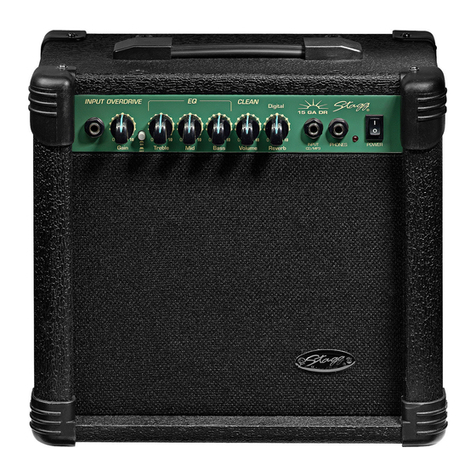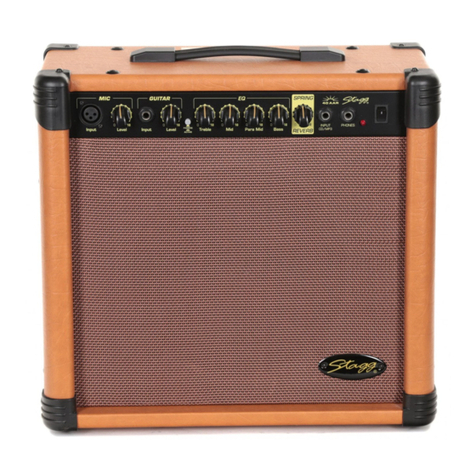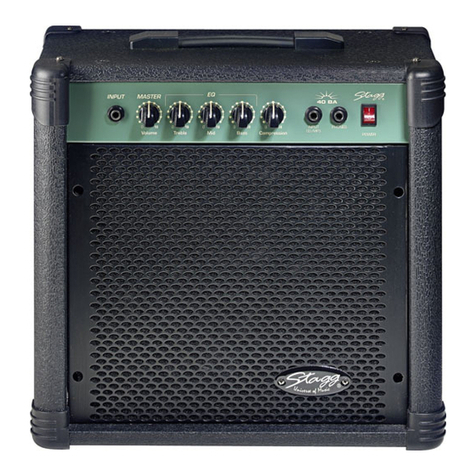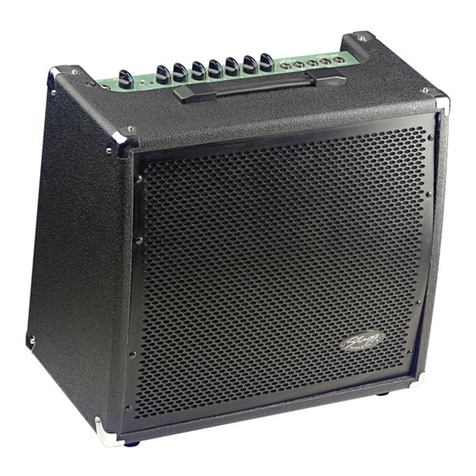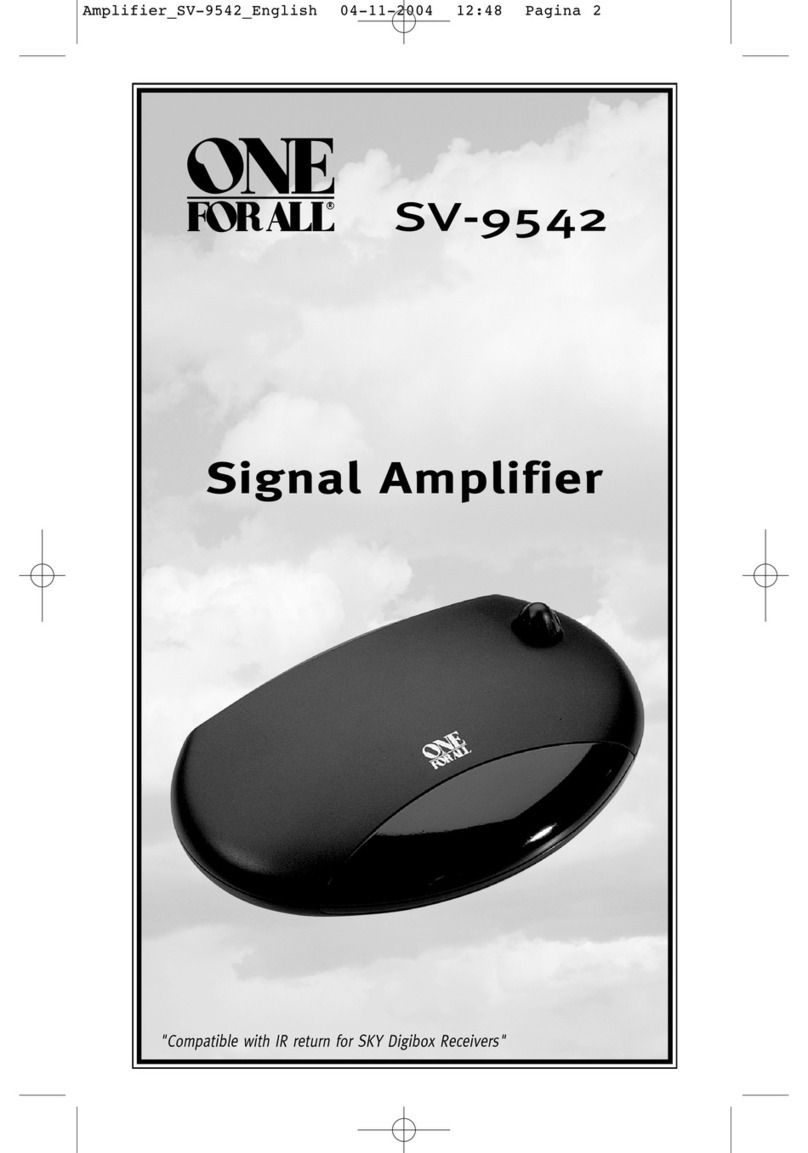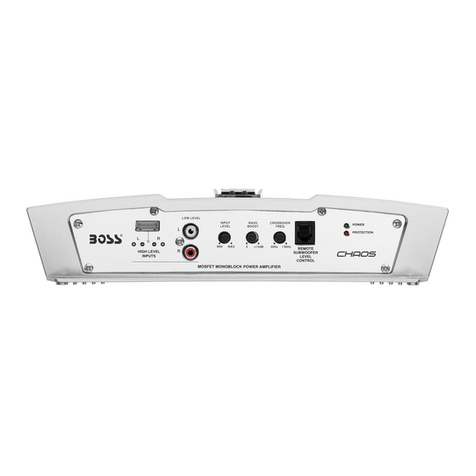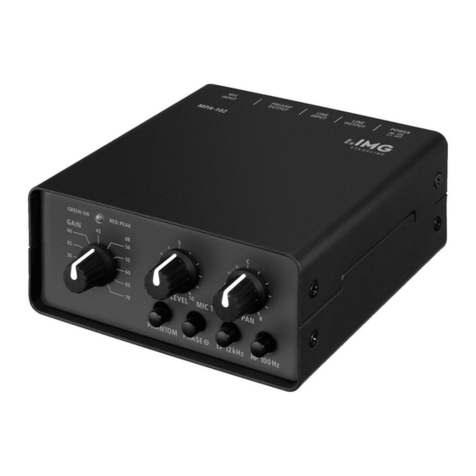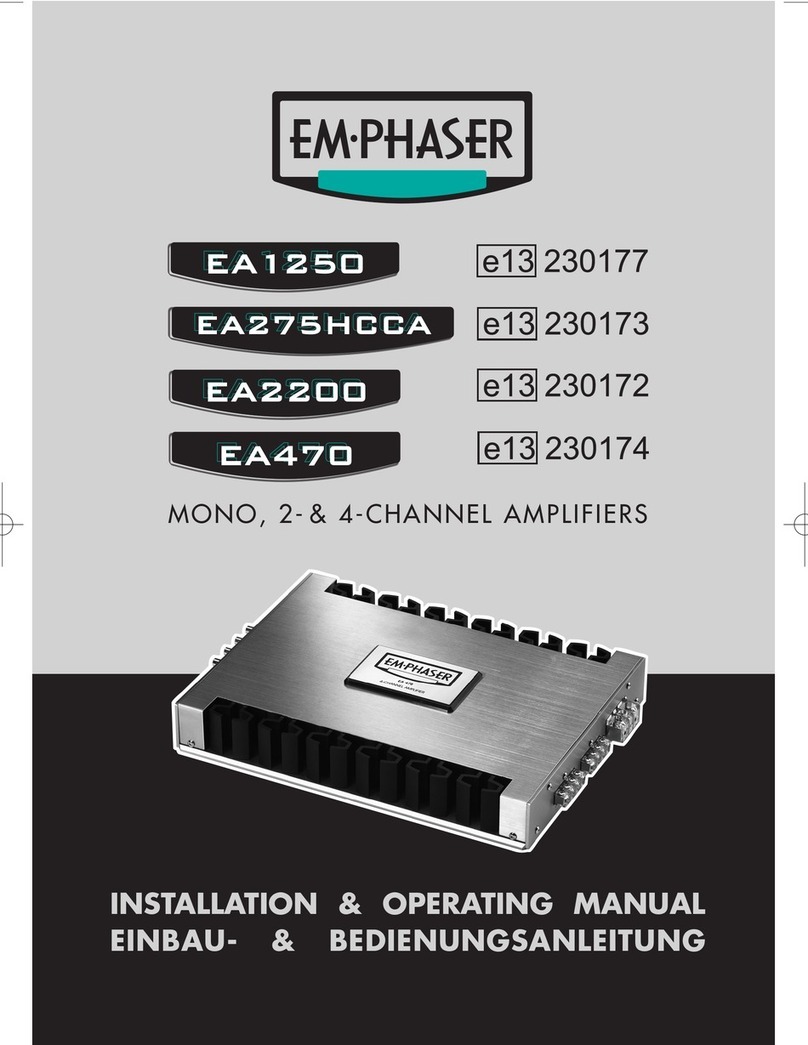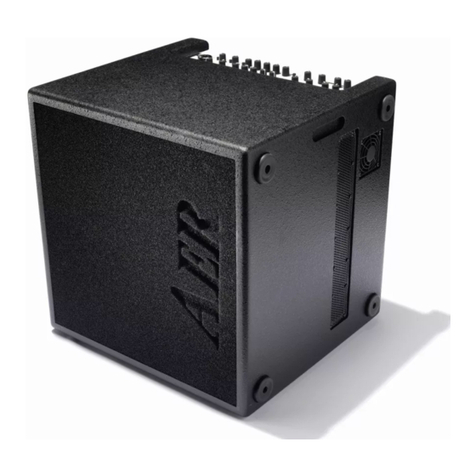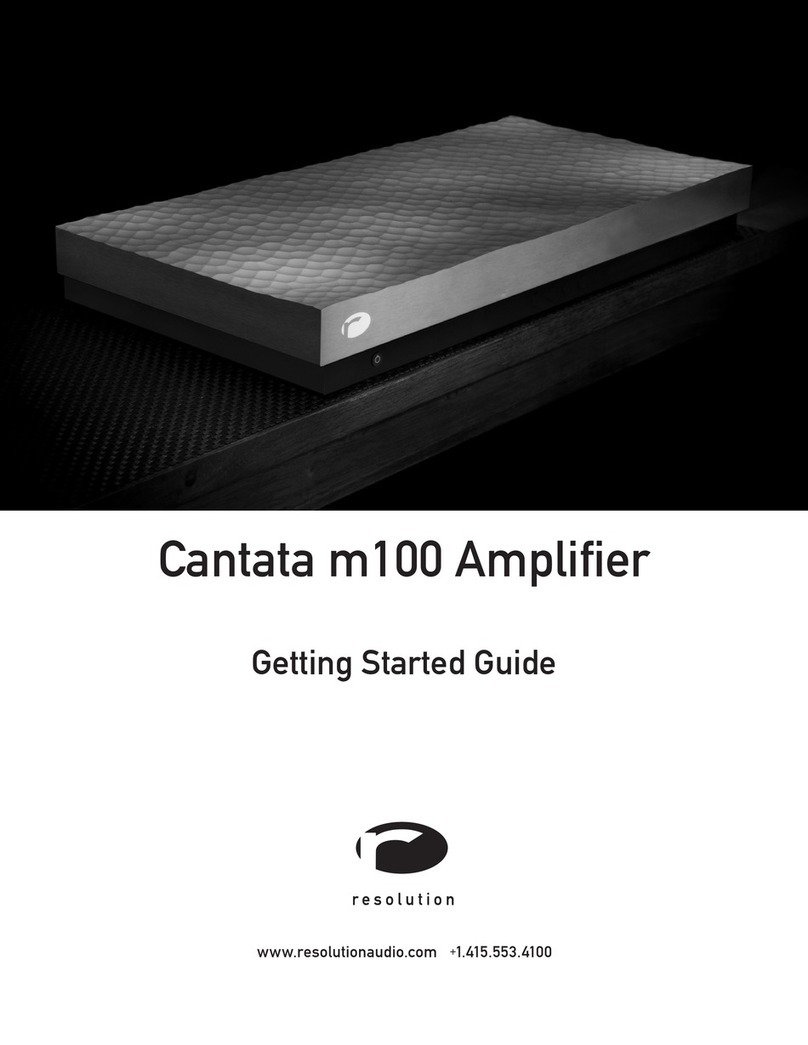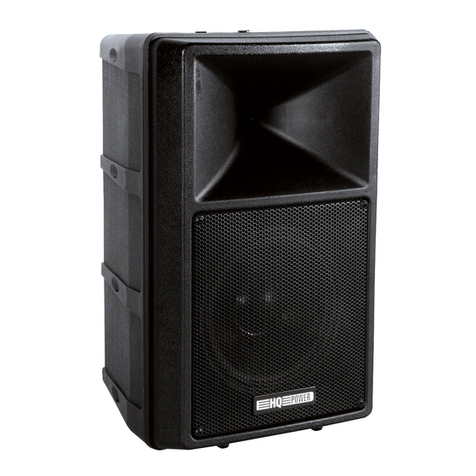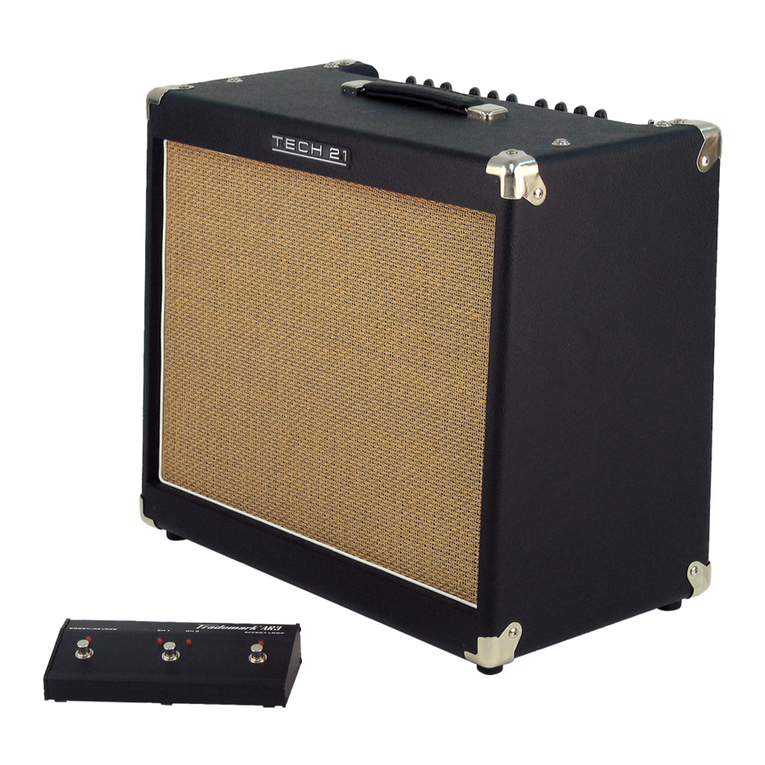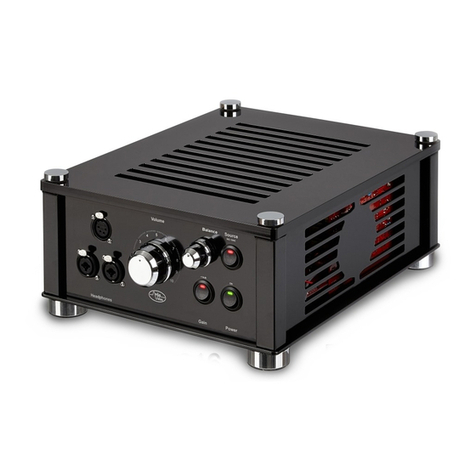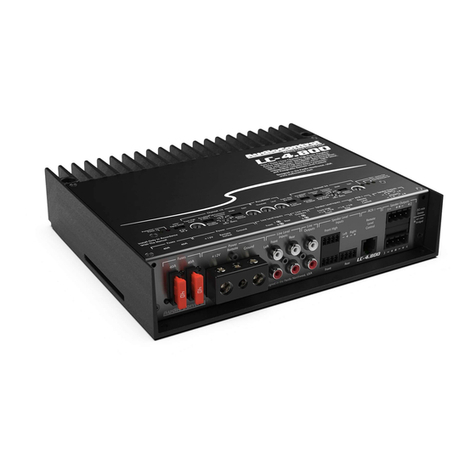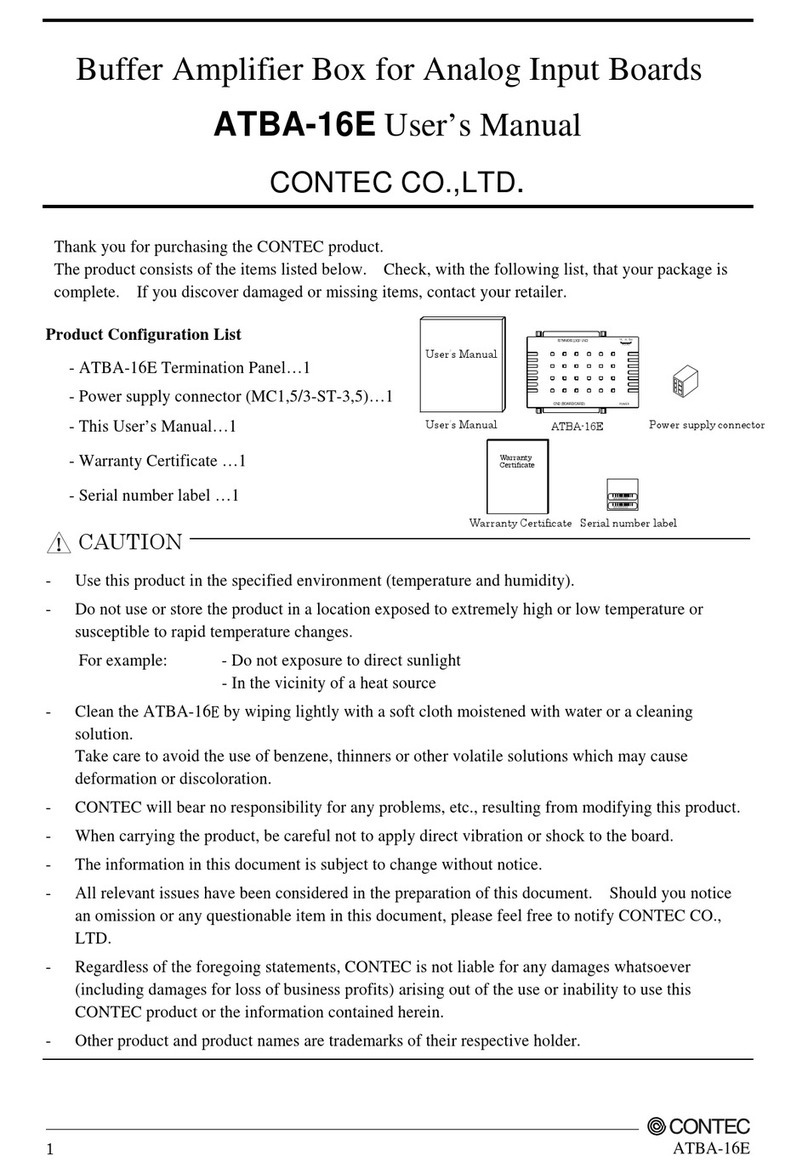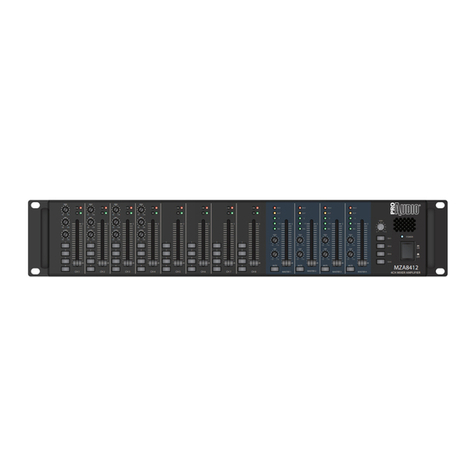Stagg SMS8P User manual

1
EN
MULTI PURPOSE AMPLIFIED SPEAKER CABINETS
2-WAY, BI-POWERED SPEAKER CABS
SMS8P, SMS10P, SMS12P, SMS15P
2-WAY, ACTIVE POWERED SPEAKER CABS W/ MP3 READER:
SMS12PLCD, SMS 15PLCD
USER’S MANUAL

2
3
• This active speaker system must be connected to a mains (AC) outlet to work properly and must
be earthed to operate safely.
• Ensure that correct AC mains voltage and socket - tted with a real ground connection – are
available before powering up the unit.
• Check mains power cable and plugs before switching on the equipment.
If the mains cable and/or plug are damaged, replace the whole cable immediately.
For your own and other people’s safety, never repair or modify the mains power cable.
Dispose of the defective cable properly for waste and recycling purpose.
• After following the instructions outlined above, if your powered speaker fails to function, please
contact your vendor.
Under no circumstances should the cabinet be opened. Leave all servicing to qualied personnel.
• Electrical appliances must never be used in conditions of high humidity or heat.
To prevent any risk of re or electric shock, never spill or splash liquids on the amplier.
Should this happen, unplug the power cable from the mains outlet and switch off the powered
speaker immediately.
• May we draw your attention to the instructions printed on the rear panel of the cabinet.
WARNING: Exposure to extremely high noise levels may cause permanent hearing damage. Please use this
amplied speaker responsibly for you and your neighbourhood.
MARKING & CONFORMITY
• The CE mark on this product means it conforms to the EMC Directive (2004/108/CE), CE marking
Directive (93/68/EEC) and Low Voltage Directive (2006/95/EC).
• The “Crossed-out Wheelie Bin” is to draw your attention to the WEEE (Waste Electric & Electronic
Equipment) Directive (2002/96/EC). It means this apparatus must be collected separately for recycling.
• “RoHS compliant” means this device conforms to the (2002/95EC) Directive on the restriction of the use of
certain hazardous substances in electrical and electronic equipment, such as: Mercury, Lead, Cadmium,
Hexavalent Chromium, Polybrominated Buphenyl (PBB) and Polybrominated
Diphenyl Ethers (PBDE).
IMPORTANT SAFETY INSTRUCTIONS
READ AND KEEP THESE INSTRUCTIONS. HEED ALL WARNINGS.
RoHS
compliant

2
3
Thank you for purchasing your new Stagg SMS Powered Speaker Cabinet.
Stagg SMS series powered speakers with integral mixer section are designed as multi purpose tools with output
powers ranging from true 90 to 220 Watts RMS, making them ideal as stand alone (mini) PA systems or as
part of larger amplication systems when connected to a mixing console, additional powered speaker(s) or
any other PA equipment.
Stagg SMS8P/10P/12P and 15P models are bi-amplied models featuring an electronic crossover and two
separate output power stages, one driving a powerful 8”, 10”, 12” or 15” Woofer to thoroughly reproduce
low and mid end frequencies, the second one linked to a compression horn tweeter for accurate high end
frequencies reproduction.
Stagg SMS12PLCD and 15PLCD models are active speaker cabinets equipped with one mono, large band,
power amplier combined to a passive cross-over that splits the audio signal range in two separate ways: one
to the 12” or 15” Woofer for the low and medium frequencies, the other one to the compression horn tweeter
for the high frequencies.
SMS12/ 15PLCD models also come with a built-in MP3 player section including USB and SD card inputs, LC
Display, front selectable push switches and remote control.
Each Stagg SMS series powered speaker features a sturdy compression horn tweeter with wide Titanium
diaphragm (1), a rugged, woofer with heavy Ferrite magnet and large voice coil, protected by a resistant, metallic
grille (2), all housed in a heavy-duty ABS nylon bre cabinet with built-in pole mount socket (4) with locking
screw (8) for use with a tripod-style stand, rubber feet (3) on the bottom for portable applications, corresponding
stacking notches (5) for stacking purposes and rigging points (6) on the top, bottom, and rear of the cabinet for
permanent and ight installations, and integral, ergonomic carrying handle (7) for easy transportation.
FOREWORD
MECHANICAL FEATURES
1
2
3
6
4
3
8
7
6
5

4
5
STAGG SMS8P STAGG SMS10P STAGG SMS12P
STAGG SMS12PLCD STAGG SMS15PLCD
STAGG SMS15P
3
1
6
2
9
5
12
4
13
7
14
8
17
10
11
15
16
18
19
20
For MP3 Player,
see page 6
3
1
6
2
9
4
12
5
13
7
14
8
17
15
10
11
19
18
20
16

4
5
MIC CHANNEL
1. JACK INPUT – This high impedance, ¼” stereo jack socket accepts unbalanced vocal microphones or
passive instruments with high impedance transducers or pick ups, such as electric or electro-acoustic (bass)
guitar, electric violin, electric double bass etc. We recommend the use of a high-quality shielded guitar cable to
prevent any background noise interference or unwanted feedback.
2. XLR INPUT– This low impedance, balanced XLR socket is designed to connect a low impedance dynamic
microphone. This can be a vocal mic for a singer or a speaker, or alternatively an instrument mic to amplify an
all-acoustic instrument that does not feature an onboard preamp system. You may also use this input to plug
in an electro-acoustic instrument with a balanced output signal. Wiring of the 3-pin connector is: Pin 1= Shield;
Pin 2 = Positive (Hot); Pin 3 = Negative (Cold).
3. (Mic) LEVEL – This control determines the output level for both Jack and XLR inputs of the MIC channel.
4. (Jack In), 5. (XLR In), 6. (Mic Level) – Only the SMS15P model features a second, identical MIC channel
to connect more microphones or instruments as described in paragraphs 1., 2. & 3.
LINE CHANNEL
7. (L + R) INPUTS – This line level, RCA/ Phono (RCA/ Cinch) sockets are provided for connecting stereo audio
sources such as: CD/MP3/ Tape players, or musical instruments with line level outputs, i.e: rhythm machines,
samplers, electronic keyboards, synthesizers etc. Left and Right inputs are linked together for monophonic use.
8. XLR INPUT – This line level, balanced XLR connector is designed to only accept signals from line level
equipment with balanced output such as a tape machine, a mixing console, or another (Stagg SMS) Powered
Speaker Cabinet. When the distance between the external audio device and the powered speaker cabinet
exceeds 15 feet, a balanced cable should preferably be used to minimise signal loss. Wiring of the 3-pin
connector is: Pin 1= Shield; Pin 2 = Positive (Hot); Pin 3 = Negative (Cold).
9. (Line) LEVEL – This control adjusts the output level for both Jack and XLR inputs of the LINE channel.
OUTPUT SECTION
10. JACK OUT - This ¼” stereo jack socket features a line level, pre EQ, balanced output to connect the unit
to a sound mixer, an additional (Stagg SMS) Powered Speaker Cabinet or any other (mini) Power Amplication
System.
11. XLR OUT – This low impedance, XLR connector drives a pre EQ, balanced output signal for connecting
directly to one of the balanced microphone inputs on a mixing console, either in studio or stage applications.
12. (Output) LEVEL - This control adjusts the general output level of the powered speaker, before equalization.
EQUALIZER SECTION
13. TREBLE - This ± 12 dB gain control determines the amount of high frequencies in the output signal.
Turning the knob clockwise will boost the high frequencies while turning it anticlockwise will cut the high
frequencies of the original output signal.
14. BASS - This ± 12 dB gain control determines the amount of low frequencies in the output signal. Turning
the knob clockwise will boost the low frequencies while turning it anticlockwise will cut the low frequencies of
the original output signal.
15. CLIP LED - This red LED begins to ash when the signal to the output power stage(s) becomes too loud.
When permanently lit up, it indicates distortion that could be harmful for the speakers. This means that one or
more of the Mic, Line, or Overall levels is set too high and should be at once re-adjusted until the led ashes
again or shuts off.
MAINS SECTION
16. POWER SWITCH - This switch turns the amplied speaker on or off.
17. POWER LED - When this green LED is lit, the device is powered and ready to work. When it is off, it means
the amplier is switched off.
18. AC LINE SELECT - All SMS powered speakers (except the SMS12PLCD) are tted with a switch enabling
the unit to work on two different AC mains outlets: either 110-120VAC or 220-240VAC, as appropriate. Access
to the selector is done by unscrewing the safety cover. Please mind the switch is set on the right AC Voltage
position: either 115VAC or 230VAC, before powering up the unit.
19. POWER FUSE - In the event of the power fuse having to be replaced, rst unplug the power cable from
the mains outlet. Then remove the fuse cover and replace the power fuse with one of the same type and value.
Never plug the power cable back into the mains outlet without the fuse cover. When powering on the amplier,
if the power fuse blows up again, go to a suitable service centre for repair.
20. AC (MAINS) INPUT - This is the input socket into which the moulded mains power cable must be
connected. If the socket outlets available are not suitable for the plug supplied with this equipment, use an
appropriate plug adapter that can handle the power required for this powered speaker.

6
7
1. LCD:
This large, blue LCD screen displays all relevant information about the function being selected or the MP3 le
(or song) being played.
2. FUNCTION SELECTOR: This section provides front-selectable push switches, allowing you to choose between
one of the 5 main functions requested when using the MP3 reader.
A. Repeat/ EQ
• Press this button once to play the current song repeatedly until the “stop” step is activated.
• Press this button twice and all loaded songs will be played one after the other until the
”stop“ step is selected.
• Press this button a third time to stop the repeating process.
• Press and hold this button to select among different types of equalization applied to the song currently playing.
B. Previous/ Vol -
• Press this button once to come back to the previous song.
• Press and hold this button to lower the volume of the MP3 reader.
C. Next/ Vol +
• Press this button once to go to the next song.
• Press and hold this button to increase the volume of the MP3 reader.
D. Play/ Pause
• Press this button to play the chosen song. Press it again to momentarily interrupt the playing.
Press a third time to continue the reading of the song.
E. Stop SW
• Press this button to end the song.
3. SD (Input): This slot is used to insert a SD (Secured Digital), non-volatile memory card with MP3 les to be read.
4. USB (Input): In this port, plug in any USB (Universal Serial Bus) memory stick with MP3 les to be played.
This device features all necessary push-switch selectable functions to easily operate your MP3 reader at a distance
of up to 3 metres (approximately 9.8 feet) from your audio installation. For details, please refer to the functions
explained above on this page in paragraph n°2 (FUNCTION SELECTOR), unless otherwise speci ed. The remote
control included with your product may vary from the one pictured here, depending on the region where it was
originally purchased.
MP3 READER/PLAYER (SMS 12 AND 15PLCD ONLY)
REMOTE CONTROL (SMS12 AND 15PLCD, ONLY)
1
3
7
8
1. PLAY/PAUSE (see 2.D.)
2. STOP (see 2.E.)
3. MUTE – Mutes the sound from the MP3 player.
4. REPEAT (see 2.A.)
5. USB/SD SELECT - Use this button to choose among both audio
le memory sources available: either the SD card or the USB stick.
6. VOLUME + (see 2.C.)
7. BACK (see 2.B.)
8. EQ SELECT (see 2.A.)
9. FORWARD (see 2.C.)
10. VOLUME - (see 2.B.)
11. BATTERY - The remote control unit needs a CR2025 button-cell
battery to operate. In case of malfunction, always replace with
the same type of battery. Dispose properly of the used battery for
waste and recycling purposes.
11
9
10
6
5
4
2
3
4
1
2
A B C D E

6
7
Powered Speaker Model
SMS8P
SMS8P USA
SMS10P
SMS10P USA
SMS12P
SMS12P USA
Max. Rated Power 90W RMS 160W RMS 200W RMS
Amplier System Bi-Amp Bi-Amp Bi-Amp
Woofer (Ø/ P/ Z) 8" (20cm)/ 70W/ 4Ω 10" (25cm)/ 115W/ 4Ω 12" (30cm)/ 215W/ 4Ω
Ferrite Driver (Voice Coil Size/Magnet Weight)
38mm (1.5")/ 30oz (850g) 50mm (2")/ 40oz (1.13kg) 50mm (2")/ 40oz (1.13kg)
Steel frame Steel frame Steel frame
Compression Horn Tweeter
Titanium Diaphragm (Ø/ P/ Z) 25mm (1")/ 30W/ 8Ω 34mm (1.3")/ 35W/ 8Ω 34mm (1.3")/ 35W/ 8Ω
Cross-over Electronic Electronic Electronic
Frequency Response (@ -3dB) 50Hz to 20kHz 50 Hz to 20kHz 45 Hz to 20kHz
Total Harmonic Distortion 0.2% THD 0.3% THD 0.3% THD
Signal to Noise Ratio (@ max Rated
Power)
-97dB -96dB -94dB
MIC Channel Inputs
Balanced XLR Impedance 1.2kΩ 1.2kΩ 1.2kΩ
Sensitivity 4.5mV 2.5mV 2.5mV
Stereo Jack Impedance 1.2kΩ 1.2kΩ 1.2kΩ
Sensitivity 4.5mV 2.5mV 2.5mV
LINE Channel Inputs
L + R Cinch Impedance 52kΩ 55kΩ 52kΩ
Sensitivity 120mV 56mV 56mV
Balanced XLR Impedance 10kΩ 10kΩ 10kΩ
Sensitivity 130mV 60mV 60mV
EQ Section Bass /Treble ± 12dB ± 12dB ± 12dB
Line Output (@ 1 kHz) Impedance 2kΩ 2kΩ 2kΩ
Max Gain +9.5dB +7dB +6.5dB
Max level 3V 2.4V 2V
Maximum Input Level (before clip) 120mV 60mV 60mV
Sound Pressure Level (@ 1kHz)
(or Sensitivity in dB for 1W Power @ 1m) 92dB 1W@1m 94.5dB 1W@1m 96.5dB 1W@1m
Mains Power Consumption 200W 352W 445W
Mains Power Fuse (110V-130V/ 60Hz) T 2.5A T 3.15A T 3.15A
Mains Power Fuse (220V-240V/ 50Hz) T 1.0A T 1.6A T 2.0A
Dimensions (H x L x P) 38.5 x 28 x 22cm 47 x 34.5 x 27cm 55.5 x 40 x 31.5cm
Dimensions (H x W x D) 15.2 x 11 x 8.7in 18.5 x 13.6 x 10.6in 21.9 x 15.7 x 12.4in
Weight 8.5kg/ 18.7lbs 13.7kg/ 30.2lbs 18.3kg/ 40.3lbs
Features and Specications are subject to change without notice.
TECHNICAL SPECIFICATIONS

8
Powered Speaker Model
SMS15P
SMS15P USA
SMS12PLCD
SMS12PLCD USA
SMS15PLCD
SMS15PLCD USA
Max. Rated Power 220W RMS 180W RMS 200W RMS
Ampli er System Bi-Amp Mono Amp Mono Amp
Woofer (Ø/ P/ Z) 15" (38 cm)/250W/ 4Ω 12" (30 cm)/215W/ 4Ω 15" (38 cm)/250W/ 4Ω
Ferrite Driver (Voice Coil Size/Magnet Weight)
38mm (1.5")/30oz (850g)
75.5mm (3")/60oz (1.7kg) 60mm (2.4")/50oz (1.41kg)
Steel frame Steel frame Steel frame
Compression Horn Tweeter
Titanium Diaphragm (Ø/ P/ Z) 25mm (1")/ 30W/ 8Ω 44mm (1.7")/ 50W/ 8Ω 34mm (1.3")/ 35W/ 8Ω
Cross-over Electronic Passive Passive
Frequency Response (@ -3dB) 40Hz to 20kHz 45Hz to 20kHz 40Hz to 20kHz
Total Harmonic Distortion 0.3% THD 0.3% THD 0.3% THD
Signal to Noise Ratio (@ max Rated
Power)
-94.5dB -95dB -94.5dB
MIC Channel Inputs
Balanced XLR Impedance 1.2kΩ 1.2kΩ 1.2kΩ
Sensitivity 4mV 2.5mV 4mV
Stereo Jack Impedance 1.2kΩ 1.2kΩ 1.2kΩ
Sensitivity 4mV 2.5mV 4mV
LINE Channel Inputs
L + R Cinch Impedance 55kΩ 52kΩ 55kΩ
Sensitivity 150mV 56mV 150mV
Balanced XLR Impedance 10kΩ 10kΩ 10kΩ
Sensitivity 170mV 60mV 170mV
EQ Section Bass /Treble ± 12dB ± 12dB ± 12dB
Line Output (@ 1 kHz) Impedance 2kΩ 2kΩ 2kΩ
Max Gain +10dB +6.5dB +10dB
Max level 3V 2V 3V
Maximum Input Level (before clip) 160mV 60mV 160mV
Sound Pressure Level (@ 1kHz)
(or Sensitivity in dB for 1W Power @
1m)
97.5dB 1W@1m 96.5dB 1W@1m 97.5dB 1W@1m
Mains Power Consumption 490W 400W 445W
Mains Power Fuse (110V-130V/ 60Hz) T 5.0A T 3.15A T 5.0A
Mains Power Fuse (220V-240V/ 50Hz) T 2.5A T 2.5A T 3.15A
Dimensions (H x L x P) 66.5 x 44.5 x 40cm 55.5 x 40 x 31.5cm 66.5 x 44.5 x 40cm
Dimensions (H x W x D) 26.2 x 17.5 x 15.7in 21.9 x 15.7 x 12.4in 26.2 x 17.5 x 15.7in
Weight 25.4kg/ 56lbs 18.3kg/ 40.3lbs 25.4kg/ 56lbs
Features and Speci cations are subject to change without notice.
TECHNICAL SPECIFICATIONS
www.staggmusic.com
DISTRIBUIDOR
EMD Music 12-2010-UK
This manual suits for next models
6
Table of contents
Other Stagg Amplifier manuals
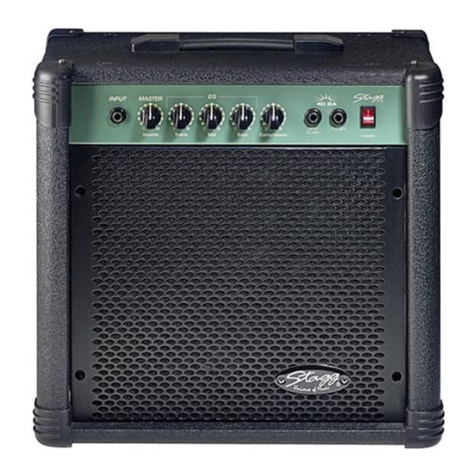
Stagg
Stagg 40 BA USA User manual
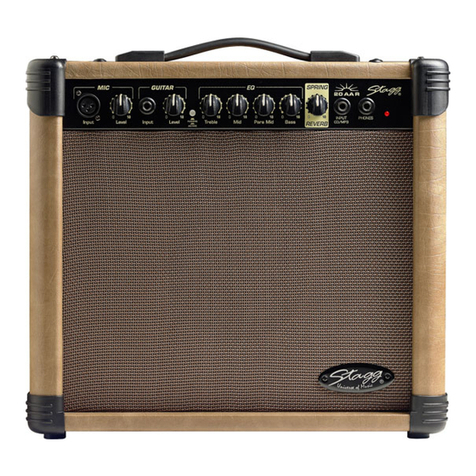
Stagg
Stagg 40 AA R USA User manual
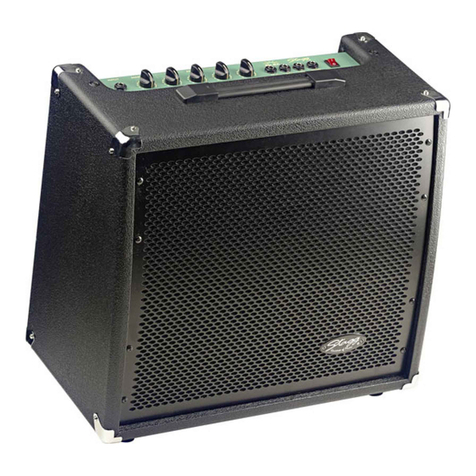
Stagg
Stagg 60 BA USA User manual
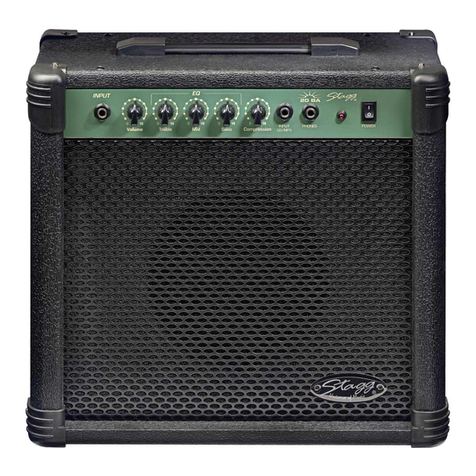
Stagg
Stagg 20 BA USA User manual
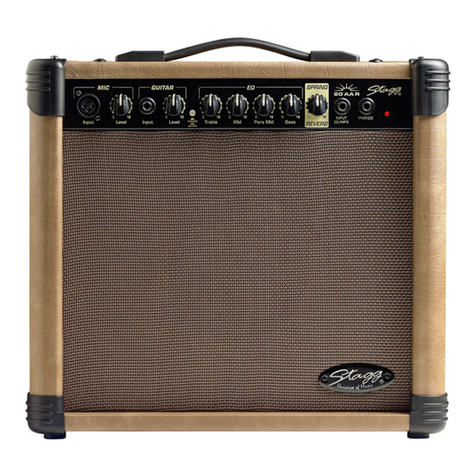
Stagg
Stagg 20 AA R USA User manual
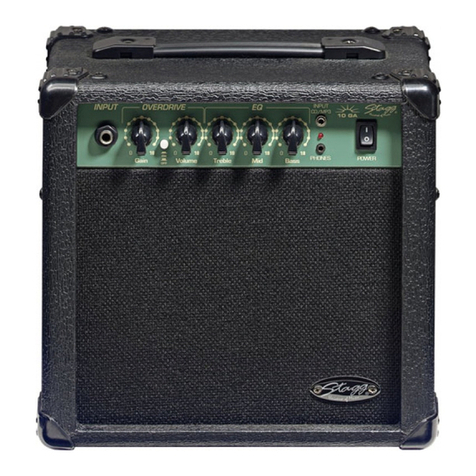
Stagg
Stagg 10 GA USA User manual
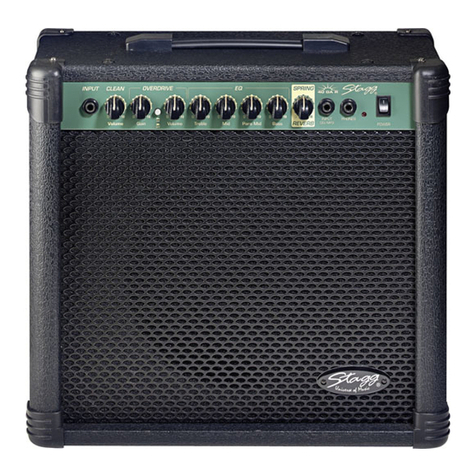
Stagg
Stagg 40 GA DSP User manual

Stagg
Stagg EDA 40 User manual

Stagg
Stagg SPA-SUB 1208 EUR User manual
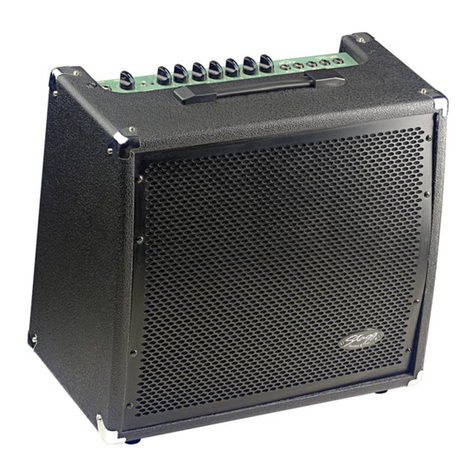
Stagg
Stagg 60 GA DSP USA User manual
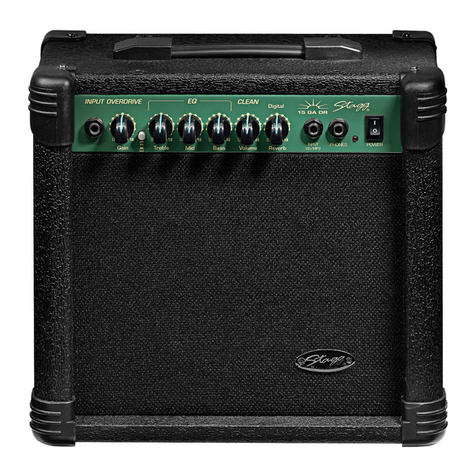
Stagg
Stagg 15 GA DR USA User manual

Stagg
Stagg 10 AA User manual

Stagg
Stagg 250 GARH EU+UK User manual
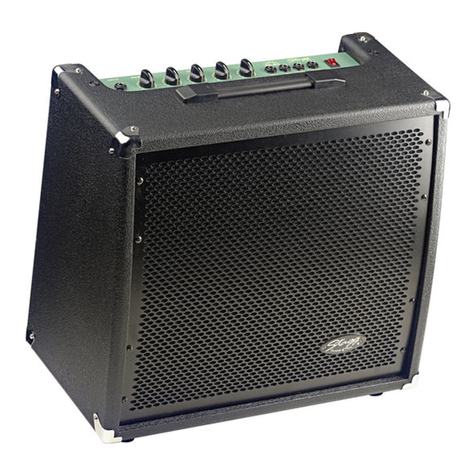
Stagg
Stagg 60 BA User manual
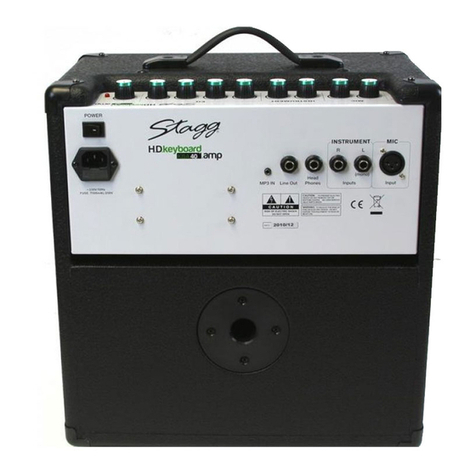
Stagg
Stagg KBA 40 User manual

Stagg
Stagg 20 BA User manual
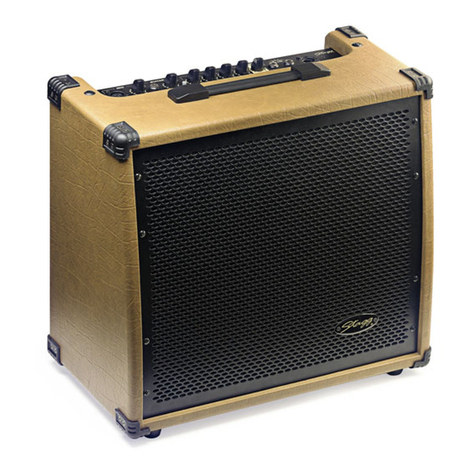
Stagg
Stagg 60 AA R User manual
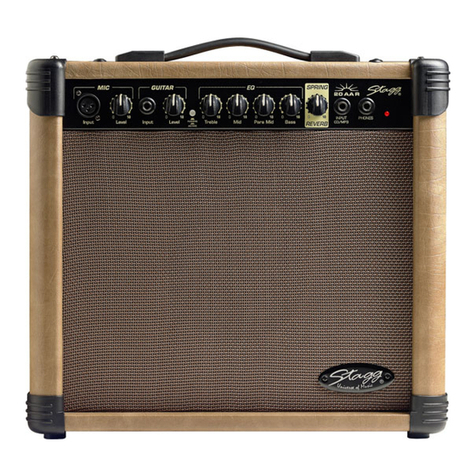
Stagg
Stagg 20 AA R User manual
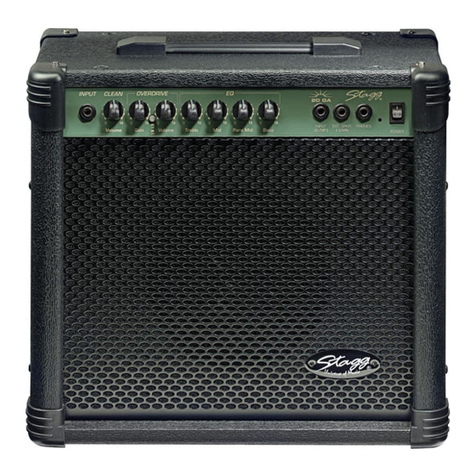
Stagg
Stagg 20 GA DR User manual
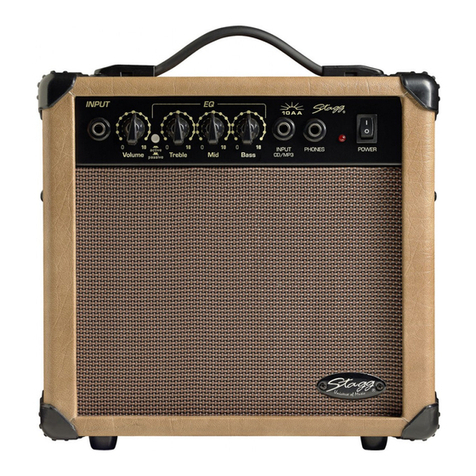
Stagg
Stagg 10 AA USA User manual
